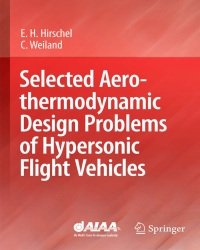Ernst Heinrich Hirschel – Selected Aerothermodynamic. Design Problems of Hypersonic Flight Vehicles
4.750 ₽
Автор: Ernst Heinrich Hirschel
Название книги: Selected Aerothermodynamic
Формат: PDF
Жанр: Авиация и космонавтика
Страницы: 522
Качество: Изначально компьютерное, E-book
Hypersonic flight and aerothermodynamics are fascinating topics. Design
problems and aerothermodynamic phenomena are partly very different for
the various kinds of hypersonic flight vehicles. These are—and will be in
the future—winged and non-winged re-entry vehicles as well as airbreathing
cruise and acceleration and also ascent and re-entry vehicles.
Both authors of the book worked for almost four decades in hypersonics:
at the German aerospace research establishment (DVL/DFVLR, now DLR)
to the end of the 1970s, then in industry (MBB/Dasa, now EADS). They
were involved in many major technology programs and projects. First, in
the early 1970s, the German ART program (Association for Re-Entry Technologies),
and, in the 1980s, the European (ESA) HERMES project and the
German Hypersonics Technology (S¨ANGER) program. Then followed, in the
1990s, the Future European Space Transportation Investigations program
(FESTIP), the Manned Space Transportation program (MSTP) with the Atmospheric
Re-Entry Demonstrator (ARD), the X-CRV Project with the X-38
vehicle and, later, the German technology programs TETRA (Technologies
for Future Space Transportation Systems), ASTRA (Selected Systems and
Technologies for Future Space Transportation Systems Applications), and
IMENS (Integrated Multidisciplinary Design of Hot Structures for Space Vehicles).
Research in the 1960s and 1970s placed great emphasis on low-density
flows, high temperature real gas effects in ground-simulation facilities and,
already, on discrete numerical computation methods. After the first flights
of the Space Shuttle Orbiter with its generally very good aerodynamic performance,
interest in low-density problems diminished. The layout of the
thermal protection systems highlighted the importance of high temperature
real gas effects, surface catalycity and laminar–turbulent transition. Numerical
methods received a large boost first during post-flight analyses of the
Orbiter flights and then, in particular in Europe, during the research and
development activities accompanying the HERMES project.
A serious problem showed up during the first Orbiter flight, viz., the hypersonic
pitching moment anomaly, which gave rise to grave concerns in the
HERMES project. This new vehicle had a shape totally different to that of the
Orbiter. The question was whether similar or other problems—undetected in the vehicle design—would become manifest during flight. Because the hypersonic
pitching moment anomaly was obviously a ground facility simulation
problem, much emphasis was put on the development and application of numerical
methods and their validation. Consequently, an experimental vehicle
was proposed, the 1:6 down-scaled MAIA. The first author of this book was
deeply involved in the definition of its scientific payload although neither
MAIA nor HERMES actually flew.
Work in the S¨ANGER program revealed that viscous effects dominate
airbreathing hypersonic flight rather than pressure or compressibility effects
as is the case in re-entry flight. Viscous thermal surface effects of all kinds,
governed by surface radiation cooling became a major focal point in hypersonic
research and design work. These are important subjects covered in a
previous publication by the first author on the basics of aerothermodynamics.
The fantastic increase in computer power in the second half of the 1990s
showed that it will be possible in future to treat the many strong couplings
between the disciplines involved in the design of hypersonic flight vehicles in
new ways. Multidisciplinary numerical simulation and optimization methods
became a major focus in ASTRA and IMENS, in which the second author
was strongly involved.
All these findings and developments, together with the responsibility of
the first author for an initial structuring of general medium and long-term
technology development and verification strategies in both the S¨ANGER
technology program and FESTIP, have shaped the content of the present
book. It discusses selected aerothermodynamic design problems of winged
and non-winged re-entry and airbreathing hypersonic flight vehicles—but not
the full vehicle design.
The work and experience of the authors are reflected in the chapters
on winged re-entry vehicles (RV-W’s), airbreathing cruise and acceleration
vehicles (CAV’s) and non-winged re-entry vehicles (RV-NW’s). Besides the
major aerothermodynamic phenomena and simulation problems, particular
trends in aerothermodynamics of these vehicle classes are discussed.
Special attention is paid to the hypersonic pitching moment anomaly of
the Space Shuttle Orbiter and to forebody aerothermodynamics of airbreathing
vehicles. Furthermore, there is a comprehensive presentation of waverider
design issues. For non-winged re-entry vehicles, trim and dynamic stability
issues are discussed. In particular, aerothermodynamic issues of stabilization,
trim and control devices are also considered.
The authors’ research, university teaching and industrial involvement have
shown that it is important to cover topics that are usually not in the major
focus of books on aerothermodynamics. These are the fundamentals of flight
trajectory mechanics, including the general equations for planetary flight, the
describing mathematical equations in general formulation of forces, moments,
center of pressure, trim and stability, as well as multidisciplinary design aspects
including the mathematical models and the coupling procedures Another outcome of the authors’ work was the recognition that it would be
useful to provide the reader with quantitative examples of the coefficients of—
at least—longitudinal motion for a variety of shapes of operational vehicles,
demonstrators, and studied concepts. In this way, numbers are available to
compare and to check the results of the readers own work. Many of the
data that we provide were generated with both numerical simulations and
experimental tests in the department formerly headed by the second author.
Although the thermal state of a vehicle surface and the ensuing thermal
loads and thermal surface effects are among the major topics of hypersonic
vehicle design, they are not treated separately in this book. Their treatment
is integrated in the corresponding chapters. However, a short overview of
the basic issues, as well as a simulation compendium, is given in a separate
chapter.
Both authors have advanced over many years the use of discrete numerical
methods of aerothermodynamics in research and in industrial applications.
These methods now permit a thorough quantification of and deep insights
into design problems and the relevant aerothermodynamic phenomena. A
good overall knowledge is necessary for their successful application, as is
an eye for the relevant features. Consequently, this book discusses in great
detail results of numerical simulations, also in view of the multidisciplinary
implications of aerothermodynamics.
The book is intended for graduate students, doctoral students, design
and development engineers, and technical managers. A useful prerequisite is
a knowledge of the basics of aerothermodynamics.
We see presently an up and down of the different modes and vehicles of
hypersonic flight. Non-winged concepts now seem to displace winged re-entry
concepts. Airbreathing hypersonic flight is a concept still waiting for its time.
Nevertheless, we are convinced that hypersonic flight has a bright future. We
hope that our book will help the reader to make himself familiar with a
number of problems regarding the aerothermodynamic design of hypersonic
flight vehicles.
April 2009
Ernst Heinrich Hirschel






Отзывы
Отзывов пока нет.